Los Glaciares
Friday, March 23rd, 2007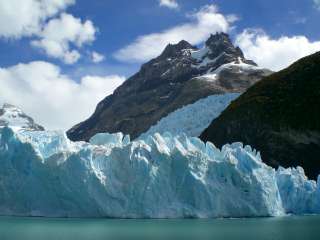 The orientation at our wonderful hostel boiled down to a few options: take the boat ride one day and hike on Perito Moreno glacier the next, unless you want to cheap out and just look at it, because that is what you do in El Calafate. There is only one tour company for the Glacier National Park and one ridiculously high price for each tour. We did as they instructed and signed up for both.
The orientation at our wonderful hostel boiled down to a few options: take the boat ride one day and hike on Perito Moreno glacier the next, unless you want to cheap out and just look at it, because that is what you do in El Calafate. There is only one tour company for the Glacier National Park and one ridiculously high price for each tour. We did as they instructed and signed up for both.
Upon boarding the boat the first day we were disappointed to find we  had to sit in the middle, far from the windows of the enormous catamaran, but we ended up spending most of our time on deck, trying to shield ourselves from the biting wind while exposing ourselves to as much sun as possible. A frenzy ensued on desk as we approached the first iceberg. Everyone suddenly became paparazzi, pushing and shoving for a prime location and lighting up the iceberg with camera flashes. A single-hulled vessel would surely have tipped over as all the passengers lurched to one side. Fortunately, everyone soon realized that the little chunk of washed up ice was hardly newsworthy, even for the tabloids or their travel blogs. We later circled dozens of larger icebergs with glassy walls, dripping arches and cobalt blue crevices.
had to sit in the middle, far from the windows of the enormous catamaran, but we ended up spending most of our time on deck, trying to shield ourselves from the biting wind while exposing ourselves to as much sun as possible. A frenzy ensued on desk as we approached the first iceberg. Everyone suddenly became paparazzi, pushing and shoving for a prime location and lighting up the iceberg with camera flashes. A single-hulled vessel would surely have tipped over as all the passengers lurched to one side. Fortunately, everyone soon realized that the little chunk of washed up ice was hardly newsworthy, even for the tabloids or their travel blogs. We later circled dozens of larger icebergs with glassy walls, dripping arches and cobalt blue crevices.
 After some other travels, we returned to El Calafate for our short trek on the glacier. Donning every warm piece of clothing we have, along with the requisite crampons, we followed our guide up ridges and over crevices. We stood over holes to peer deep into the ice sheet and tried not to drop our camera while trying to take pictures through thick cotton gloves. Janet dropped the camera. And nearly ripped her pants with the crampons. Near the end, we climbed over a ridge to find a table, a dozen glasses and a bottle of scotch. The guides chopped ice from the glacier to further chill our scotch, which we enjoyed standing on the glaciers in our crampons.
After some other travels, we returned to El Calafate for our short trek on the glacier. Donning every warm piece of clothing we have, along with the requisite crampons, we followed our guide up ridges and over crevices. We stood over holes to peer deep into the ice sheet and tried not to drop our camera while trying to take pictures through thick cotton gloves. Janet dropped the camera. And nearly ripped her pants with the crampons. Near the end, we climbed over a ridge to find a table, a dozen glasses and a bottle of scotch. The guides chopped ice from the glacier to further chill our scotch, which we enjoyed standing on the glaciers in our crampons.
Shortly afterward, we saw what we had longed for: a part of the 40 meter ice face broke away, fell into the lake, smashed into tiny pieces and created an enormous wave, which we watched propagate across the lake. One sign stated that the falling ice can throw smaller lethal chucks of ice hundreds of meters. 32 people died between 1968 and 1988.
With the rate that glaciers are melting—having added tons of carbon dioxide to the atmosphere with our plane travel—I feel fortunate to have experienced them.
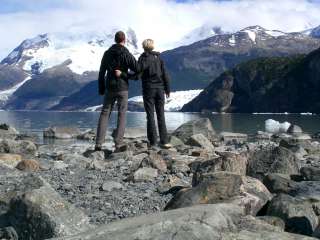
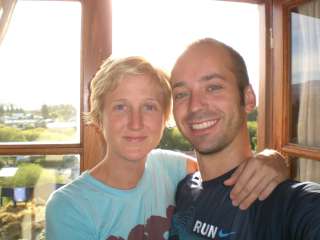
 But now we are here and the living is easy. We are rapidly learning/re-learning Spanish and consuming wine, both things that we’ve been anxiously looking forward to. Three evenings in a row, I’ve had steak for supper and I think that perhaps three might be the limit. Not so with wine, though. I can’t get enough of it or of the view we have from our room in the hostel, America Del Sur, a.k.a. the best hostel in the world. This town is perched on the edge of Lake Argentina which borders a few glaciers in the national park; I can’t see them from the window but the lake and the Andes make a glorious view at any time of day. We haven’t seen the southern cross constellation yet but I’m keeping my eyes peeled. Meanwhile, our jet lag is wearing off, our exercise is increasing, we’re breathing lots of fresh, cool air and are starting to feel invigorated with some the thought of some brilliant hiking in our near future.
But now we are here and the living is easy. We are rapidly learning/re-learning Spanish and consuming wine, both things that we’ve been anxiously looking forward to. Three evenings in a row, I’ve had steak for supper and I think that perhaps three might be the limit. Not so with wine, though. I can’t get enough of it or of the view we have from our room in the hostel, America Del Sur, a.k.a. the best hostel in the world. This town is perched on the edge of Lake Argentina which borders a few glaciers in the national park; I can’t see them from the window but the lake and the Andes make a glorious view at any time of day. We haven’t seen the southern cross constellation yet but I’m keeping my eyes peeled. Meanwhile, our jet lag is wearing off, our exercise is increasing, we’re breathing lots of fresh, cool air and are starting to feel invigorated with some the thought of some brilliant hiking in our near future.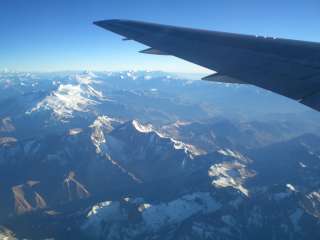

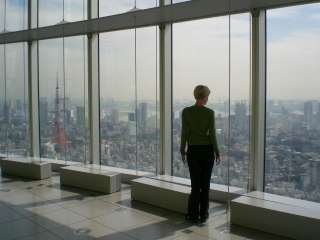 Apparently, it’s quite rare to see Mount Fuji when in Tokyo. Even if one pays the fee to ascend to one of the observation decks in Tokyo, one may not be able to see the mountain unless it’s an exceptionally clear day. When we visited the observation deck of the Mori Art Museum, it was not an exceptionally clear day. Meh, we saw it from the plane anyway.
Apparently, it’s quite rare to see Mount Fuji when in Tokyo. Even if one pays the fee to ascend to one of the observation decks in Tokyo, one may not be able to see the mountain unless it’s an exceptionally clear day. When we visited the observation deck of the Mori Art Museum, it was not an exceptionally clear day. Meh, we saw it from the plane anyway. Our second most expensive view (after the New York Bar extravaganza), is the view from our hotel room in Asakusa. If we hadn’t been using credit card points to pay for it, we would not have been able to stay in this hotel. In fact, there is little evidence to suggest we could afford any hotel in Tokyo and would likely have been staying in a dorm room in the cheapest hostel available or a love motel, if we were lucky. However, 10 years’ worth of points collecting afforded us three nights in a room with a view of Senso-ji temple.
Our second most expensive view (after the New York Bar extravaganza), is the view from our hotel room in Asakusa. If we hadn’t been using credit card points to pay for it, we would not have been able to stay in this hotel. In fact, there is little evidence to suggest we could afford any hotel in Tokyo and would likely have been staying in a dorm room in the cheapest hostel available or a love motel, if we were lucky. However, 10 years’ worth of points collecting afforded us three nights in a room with a view of Senso-ji temple.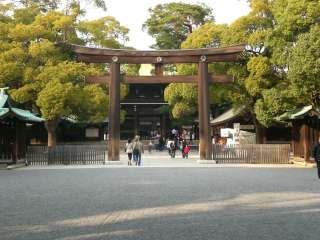 Even with a short stay of three frigid days (relative to Bangkok, at any rate), we packed in the temple visits. There was a climb through the red tunnel of shrine gates and up the steps to Hie-Jinja shrine and a stop at the exquisite Meiji-jingu Shinto shrine, which was arguably the prettiest temple/church/mosque/shrine we’ve seen on this RTW trip. Despite the crowds there on that Saturday afternoon, it maintained a remarkably peaceful atmosphere.
Even with a short stay of three frigid days (relative to Bangkok, at any rate), we packed in the temple visits. There was a climb through the red tunnel of shrine gates and up the steps to Hie-Jinja shrine and a stop at the exquisite Meiji-jingu Shinto shrine, which was arguably the prettiest temple/church/mosque/shrine we’ve seen on this RTW trip. Despite the crowds there on that Saturday afternoon, it maintained a remarkably peaceful atmosphere.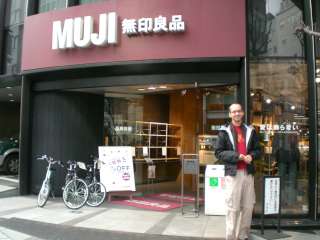 So far, we’ve only been lucky enough to see two others: one in Paris and one in Bangkok, and each spotting is accompanied with a sharp intakes of breath and much excited hand-fluttering. Therefore, we couldn’t miss the opportunity to see a branch in Tokyo, the heart of it all, the place where design and form match function and style and then go on sale. Maybe our hopes were pinned a little high – just maybe – because this Muji fell kind of short of our expectations. Though that didn’t stop us from combing the store and dreaming of the apartment we’ll one day have and Mujify.
So far, we’ve only been lucky enough to see two others: one in Paris and one in Bangkok, and each spotting is accompanied with a sharp intakes of breath and much excited hand-fluttering. Therefore, we couldn’t miss the opportunity to see a branch in Tokyo, the heart of it all, the place where design and form match function and style and then go on sale. Maybe our hopes were pinned a little high – just maybe – because this Muji fell kind of short of our expectations. Though that didn’t stop us from combing the store and dreaming of the apartment we’ll one day have and Mujify.
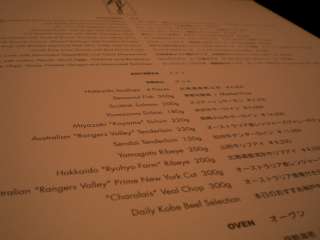 According to the menus, those were just appetizers but even in our alcohol infused state, we could not justify spending $80 for a rib eye steak or – perish the thought – $190 for the Kobe beef steak. We did have one more glass of wine, though. In total, for two people, two drinks each, two appetizers: $200CAD. Obscene, opulent, delicious, exquisite. Unrepeatable.
According to the menus, those were just appetizers but even in our alcohol infused state, we could not justify spending $80 for a rib eye steak or – perish the thought – $190 for the Kobe beef steak. We did have one more glass of wine, though. In total, for two people, two drinks each, two appetizers: $200CAD. Obscene, opulent, delicious, exquisite. Unrepeatable. Rising at dawn, we visited the Tsukiji Fish Market for the height of the morning rush. After navigating our way through the trucks, vans and motorized trolleys, we found the main fresh fish market with hundreds of vendors selling fish whole, filleted or still alive. Men ran frozen tuna through enormous band saws while others filleted eel after eel or sliced off chunks of fish with a knife three feet long, any of these jobs requiring rubber boats, plastic pants and a wet suit like jacket to keep warm and dry.
Rising at dawn, we visited the Tsukiji Fish Market for the height of the morning rush. After navigating our way through the trucks, vans and motorized trolleys, we found the main fresh fish market with hundreds of vendors selling fish whole, filleted or still alive. Men ran frozen tuna through enormous band saws while others filleted eel after eel or sliced off chunks of fish with a knife three feet long, any of these jobs requiring rubber boats, plastic pants and a wet suit like jacket to keep warm and dry.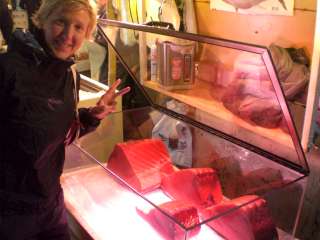 Some of the tourists wore plastic bags on their shoes, but that is dangerous on slippery concrete floors running with water and blood. With fish and guts everywhere, I was surprised by the complete lack of smell. Perhaps it’s different in the summer, but on our visit everything was surprisingly fresh.
Some of the tourists wore plastic bags on their shoes, but that is dangerous on slippery concrete floors running with water and blood. With fish and guts everywhere, I was surprised by the complete lack of smell. Perhaps it’s different in the summer, but on our visit everything was surprisingly fresh.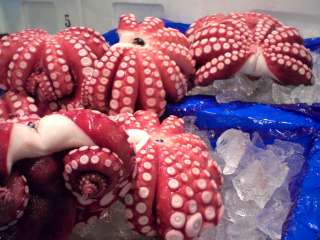 It was hard not to consider the enormity of it all—a vast industry cleaning the ocean of edible life. At no point could we see the entire market and this was only one market in one city. Live sea cucumber to whale bacon, all prepared or packaged to feed our enormous population.
It was hard not to consider the enormity of it all—a vast industry cleaning the ocean of edible life. At no point could we see the entire market and this was only one market in one city. Live sea cucumber to whale bacon, all prepared or packaged to feed our enormous population.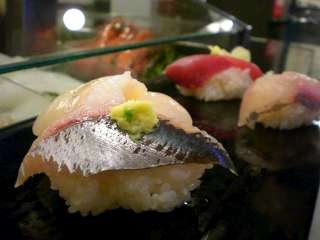 Those contemplations didn’t stop us from enjoying a sushi breakfast at one of the many restaurants that fringe the market. In Tokyo, few people speak English, but most people are used to dealing with people who don’t speak Japanese. In this case we were directed to the wall menu for a choice of the $20 set or the $30 set and an Engligh drink menu was provided. As the sushi chef completed a serving, he dropped it in front of us on a black laquered board that ran around the bar, which was used instead of a plate. Wow, so fresh. Most were the usual suspects, tuna and shrimp, but one animal we only reconginized from the fish market—a sort of dark flattened shrimp. It tasted much stronger than a shrimp, not something I’ll likely seek again.
Those contemplations didn’t stop us from enjoying a sushi breakfast at one of the many restaurants that fringe the market. In Tokyo, few people speak English, but most people are used to dealing with people who don’t speak Japanese. In this case we were directed to the wall menu for a choice of the $20 set or the $30 set and an Engligh drink menu was provided. As the sushi chef completed a serving, he dropped it in front of us on a black laquered board that ran around the bar, which was used instead of a plate. Wow, so fresh. Most were the usual suspects, tuna and shrimp, but one animal we only reconginized from the fish market—a sort of dark flattened shrimp. It tasted much stronger than a shrimp, not something I’ll likely seek again.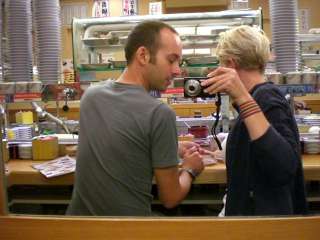 Just before we left Bangkok, we used up our last remaining bhat on a spicy green mango salad that was so spicy that I could see through time. We stopped in Seoul the next morning on a layover that was long enough to eat bibimbap with kimchi for breakfast, something we’ve been craving for months. Finally, we arrived in Japan and had a late lunch of a lot of sushi. I doubt we’ll be able to come close to replicating that phenomenon in the future, unless we have maple syrup in the morning and cross the border for American cheese in the afternoon. Doesn’t seem as exotic, though.
Just before we left Bangkok, we used up our last remaining bhat on a spicy green mango salad that was so spicy that I could see through time. We stopped in Seoul the next morning on a layover that was long enough to eat bibimbap with kimchi for breakfast, something we’ve been craving for months. Finally, we arrived in Japan and had a late lunch of a lot of sushi. I doubt we’ll be able to come close to replicating that phenomenon in the future, unless we have maple syrup in the morning and cross the border for American cheese in the afternoon. Doesn’t seem as exotic, though. Our last day in Bangkok was spent milling around CentralWorld, a new mall with a grocery store of culinary delights. It was rated the 3rd best food retailer in the world and best in Asia. Grocery aisles intertwine with sit-down options, where customers can order sushi, bistro food, or New York pizza. A liquor section had dozens of brands of beer we had never seen before. We mainly stayed near food court that overlooked the store.
Our last day in Bangkok was spent milling around CentralWorld, a new mall with a grocery store of culinary delights. It was rated the 3rd best food retailer in the world and best in Asia. Grocery aisles intertwine with sit-down options, where customers can order sushi, bistro food, or New York pizza. A liquor section had dozens of brands of beer we had never seen before. We mainly stayed near food court that overlooked the store. The Murahata Fruit Boutique, which was attached to the store, was particularly intriguing. Rather than buying a dozen apples or a bag of kiwi, one buys one apple the size of a softball or perhaps a pair of different apples, including one with a chinese character printed on the side. Whether the fruit is apple, kiwi or melon, each piece is the best of the farmers’ craft, the pinnacle of a simple tradition. Each is perfect in appearance and exceptional in flavour. The melons have perfect T-shaped stems, the kiwis are the size of a fist and the strawberries are bright red. I was able to sample one small piece of apple, which was mild and sweet, not acidic or sharp. As tempted as a was, I couldn’t convince myself to buy the $4 apple or the $20 melon.
The Murahata Fruit Boutique, which was attached to the store, was particularly intriguing. Rather than buying a dozen apples or a bag of kiwi, one buys one apple the size of a softball or perhaps a pair of different apples, including one with a chinese character printed on the side. Whether the fruit is apple, kiwi or melon, each piece is the best of the farmers’ craft, the pinnacle of a simple tradition. Each is perfect in appearance and exceptional in flavour. The melons have perfect T-shaped stems, the kiwis are the size of a fist and the strawberries are bright red. I was able to sample one small piece of apple, which was mild and sweet, not acidic or sharp. As tempted as a was, I couldn’t convince myself to buy the $4 apple or the $20 melon.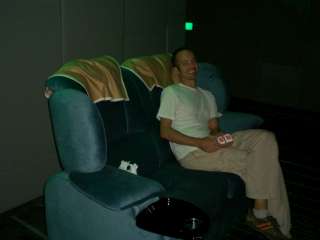 We did spend the extra $2 to get the sofa seat at the movie theatre when we watched Pursuit of Happiness. In addition to the typical cup holder, a small tray was provided and the seat backs reclined. And best of all, no arm rest to prevent snuggling.
We did spend the extra $2 to get the sofa seat at the movie theatre when we watched Pursuit of Happiness. In addition to the typical cup holder, a small tray was provided and the seat backs reclined. And best of all, no arm rest to prevent snuggling.